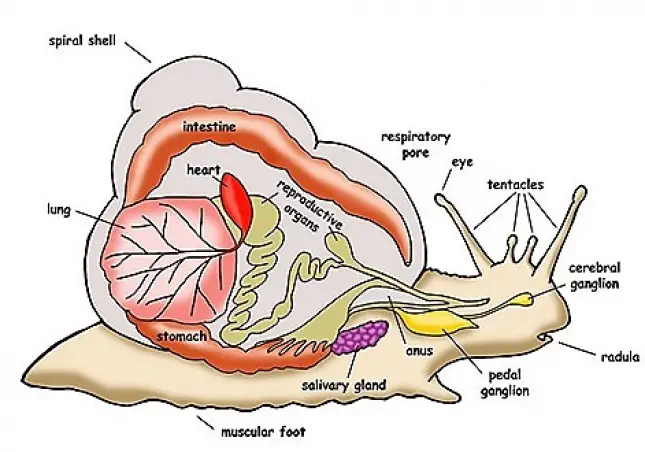Medically reviewed and approved by a board-certified member
Zoology
BLOOD VASCULAR SYSTEM IN PILA (SNAIL)
By BS MediaTwitter Profile | Updated: Sunday, 04 June 2017 18:16 UTC

The blood vascular system cf Pila includes sinuses and blood vessels. This system contains
- Blood
- Heart, Pericardium
- Arteries
- Veins
- Sinuses
1. Blood
- It is liquid tissue. It contains plasma and amoeboid cells.
- It is bluish liquid.
- In the plasma "haemocyanin" is dissolved.
- The amoeboid cells will work as phagocytes. They also absorb nitrogenous waste metrials.
Functions of Blood
- It will distribute digested food to all body parts.
- It will distribute 02to the tissue.
- It will cany excretory wastes to the excretory organ.
2. Heart & Pericardium
In visceral mass at the anterior end on the stomach a heart is present. It is covered by pericardium.
In the heart two chambers are present,
a) Auricle: It is made by thin walls. It is triangular. It shows contractions and relaxations.
b) Ventricle: Its walls are thick. It is muscular. Its inner walls are spongy in nature.
c) In between the auricle and ventricle a auriculo - ventricular opening is present.
d) At this opening a pair of semilunar valves are present. They will allow the blood to flow in a single direction.
3. Arteries
From the ventricle a aorta will arise. It will divide into cephalic aorta an visceral aorta.
a) Cephalic Aorta: It will travel anteriorly. At its base a vesicle is present. It is called aorta vesicle. Its contractions help in blood circulation. This aorta gives the following branches
- Cutaneous artery - to skin
- Oesophageal artery - to oesophagus.
- Left pallial artery - to the left pallium.
- Pericardial artery - It enters into pericardium.
The pericardial artery will finally reach the renal sacs. After giving these branches the cephalic aorta will travel to the left of the oesophagus and give the following branches.
- Radular artery - to radula.
- Retinal artery - to eye.
- Tentacular artery - to the tentacles.
- Pedal artery - to the foot.
b) Visceral Aorta: It will travel to the posterior end. It supplies blood to the visceral mass. It gives the following arteries.
- Small Pericardial artery - to the pericardium.
- Big Gastric artery - to the stomach
- Many Intestinal arteries - to the intestine.
- Many Renal arteries - to the kidney.
- Big Mesentric artery - to the intestine.
- Many Gonidial arteries - to the gonads.
At the end the visceral aorta end as branches on the rectum wall.
4. Sinuses
Arteries will supply blood to all body parts. This blood will enter into small sinuses. All these sinuses will unite to form big sinus. It is called Haemocoel. From this big sinus the blood will enter into veins. These sinuses are 4 in number.
- Perivisceral sinus: It is present around the oesophagus at the anterior and.
- Periintestinal sinus: It is present around the intestine at its posterior end.
- Branchio - renal sinus: It is present around the ctenidium.
- Pulmonary sinus: It is present around the pulmonary sac.
These sinuses are connected with veins.
5. Veins
From the sinuses veins will arise. They carry blood to the heart.
- Efferent pulmonary vein: It will collect blood from puimonary sac and caiTy to heart.
- Afferent ctenidial vein: It will carry blood to ctenidium.
- Efferent ctenidial vein: It will collect blood from ctenidium and carry it to heart.
- Afferent renal vein: It will supply blood to kidneys.
- Efferent renal vein: It will collect blood from kidneys and carry it to heart
Blood Circulation: Blood from ventricle will go to aorta. It will supply blood to all body parts. From the body parts sinuses will collect blood.
From sinuses veins will arise They bring blood back to heart.
- From pulmonary sac pure blood is carried to heart by efferent pulmonary vein.
- From ctenidiun pure blood is carried to heart by efferent ctenidial vein.
- From kidneys the blood is carried to heart by efferent renal vein.
Tags:
End of the article